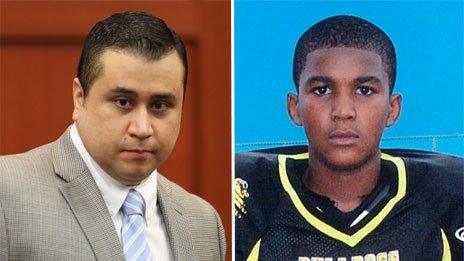Profiles: Trayvon Martin and George Zimmerman
- Published

George Zimmerman's home and the house where Martin was staying were in the same complex
On 26 February 2012, George Zimmerman was patrolling the Retreat at Twin Lakes, a gated neighbourhood in the city of Sanford, Florida, as part of the volunteer neighbourhood watch he had founded.
Trayvon Martin was walking back from a store to his father's fiancee's house.
By the end of their encounter Trayvon Martin was dead and George Zimmerman's life had changed forever. What actually happened that night has been intensely debated ever since.
Trayvon Martin
The 17-year-old high school junior lived in Miami.
His parents divorced in 1999, and Martin lived with his mother. He had played youth football.
According to a family member, Martin studied aviation through a part-time school programme, hoping to fly or become an engineer.
In the week before his death he was on suspension from school for reportedly possessing a plastic bag with traces of marijuana. His father, Tracy Martin, told USA Today, external he hoped a short stay in Sanford, Florida, would teach his son a lesson.
Martin also tweeted, changing his username at least once and writing thousands of tweets about his high school, sex and his favourite snacks.
Friends and teachers at Michael D Krop Senior High described him as a "funny guy" and "very creative".
Without ID on him at the time of the shooting, Martin was labelled as a "John Doe" by Sanford police and at the morgue until his father reported him missing.
George Zimmerman
George Zimmerman, 29, the son of a white father and Hispanic mother, was born in Virginia and moved to Sanford in 2009 with his wife.
Mr Zimmerman had asked a neighbour in Virginia for a recommendation letter to a police academy programme, but never applied.
Records show he had previously worked at a car dealership and sold insurance, but what he was doing at the time of the shooting is unclear. A defence witness has said Mr Zimmerman was in the process of starting a business.
He also attended a citizen's police academy with the Seminole Sheriff's Office.
A spokeswoman described the once-a-week scheme that totalled 14 hours as an educational tool to teach residents about police work, not a training programme.
In 2005, Mr Zimmerman was arrested for shoving a state alcohol agency officer near a bar.
The charge was later dropped when he agreed to fulfil a "pre-trial diversion" programme for first-time offenders, which usually involves fines and anger management classes.
Shortly after, a girlfriend took out a restraining order, following an argument where each accused the other of being the aggressor.
Mr Zimmerman possessed a concealed-carry permit for a 9mm handgun.
As a neighbourhood watch volunteer, he had called Sanford's police department 46 times over the previous eight years. A friend told the court he had taught Mr Zimmerman firearm safety.
According to neighbours, Mr Zimmerman organised the neighbourhood watch during a rash of burglaries in the community.
One neighbour said the 29-year-old had caught a thief while patrolling the neighbourhood.